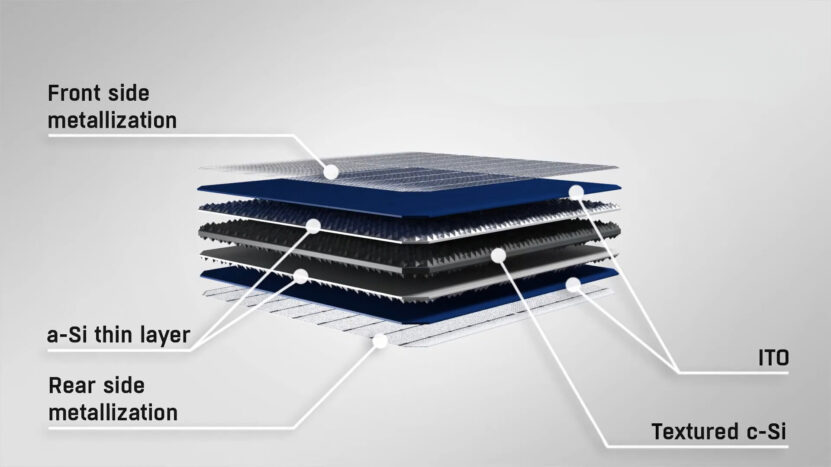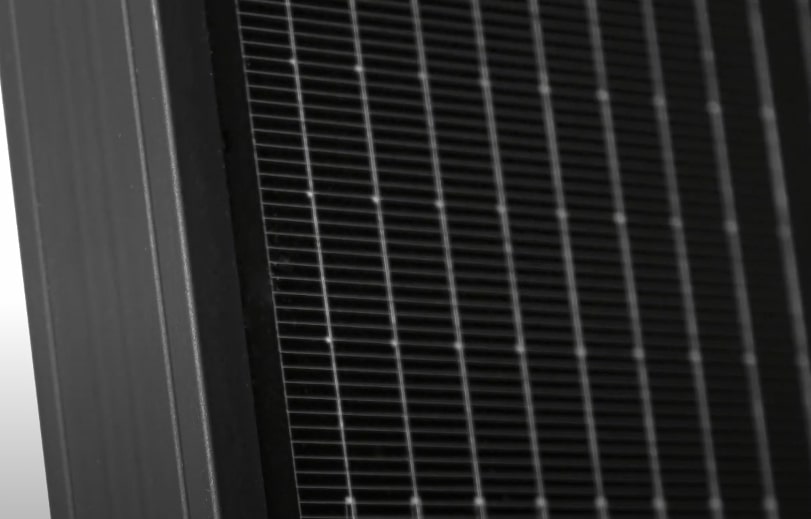HJT solar panels are leading the charge in solar power advancements. They deliver some of the best efficiency rates in the industry, and their unique construction makes them stand out.
By combining two types of silicon, they capture more sunlight and convert it into electricity at a faster rate.
Over time, HJT panels also degrade slower, which means they keep producing power at high levels for decades.
This article will provide more info about the use of Heterojunction Technology.
Key Takeaways
- Heterojunction (HJT) technology combines crystalline silicon and amorphous silicon layers, leading to high-efficiency rates of over 26% and superior energy conversion.
- HJT panels have lower degradation rates, losing just 0.35% efficiency per year, which ensures long-term reliability and stable energy production.
- The bifacial design of HJT panels allows them to absorb sunlight from both sides, increasing total energy output by up to 30% in reflective environments.
What Makes HJT Solar Panels So Efficient?
HJT solar panels stand out in the solar industry due to their exceptional efficiency, which is often over 26%. This efficiency boost comes from the unique combination of crystalline silicon (c-Si) and amorphous silicon (a-Si) layers.
Key Factors Driving Efficiency

1. Three-Layer Absorption
- Crystalline Silicon (c-Si): This layer handles most of the energy conversion, absorbing the bulk of the sunlight.
- Amorphous Silicon (a-Si): The front and back layers reduce recombination losses, meaning fewer electrons are lost before they can generate electricity.
2. Lower Temperature Sensitivity
HJT panels have a temperature coefficient of about -0.24%/°C. This means that for every degree Celsius the temperature rises, the panel loses only 0.24% of its power output. In contrast, traditional PERC panels lose 0.35% per degree Celsius.
3. Bifacial Design
With a bifacial efficiency of up to 95%, HJT panels absorb light from both sides. This can increase overall energy generation by 20-30%, depending on installation conditions.
How HJT Panels

Perform in Different Climates
HJT solar panels excel in various environmental conditions, outperforming many traditional technologies. Their design gives them a significant edge, particularly in hot climates and areas with fluctuating weather.
Performance in Hot Climates
One of the key advantages of HJT panels is their low temperature coefficient, which sits at around -0.24%/°C. This means that as temperatures increase, HJT panels lose less power compared to traditional PERC panels, which have a coefficient of -0.35%/°C.
In hotter regions, like deserts or tropical zones, this lower coefficient allows HJT panels to maintain stable performance where other panels might experience a significant drop in efficiency.
Real Impact
- In regions where temperatures often exceed 30°C, PERC panels may lose up to 10% of their efficiency, while HJT panels typically lose less than 7%.
- Over the course of a year, HJT panels in hotter climates can produce up to 15% more energy than standard monocrystalline panels.
Resilience in Cold and Low-Light Conditions
HJT panels also perform exceptionally well in low-light or cold environments. The bifacial design allows the panels to absorb light from both sides, increasing energy production by 20-30% depending on ground reflectivity. This feature is especially beneficial in snowy regions, where reflected sunlight off snow-covered ground enhances the total energy capture.
Cold Climate Advantages
- In cloudy or winter conditions, HJT panels maintain higher power output due to their dual-sided absorption capabilities.
- Their performance under diffuse light conditions is superior to conventional panels, making them more efficient during shorter daylight hours.
Comparing HJT to Traditional Solar Technologies
| Feature | HJT Panels | PERC Panels | TOPCon Panels |
|---|---|---|---|
| Efficiency | Up to 26.5% | 21-22% | 22-23% |
| Degradation Rate | 0.35% per year | 0.45% per year | 0.4% per year |
| Temperature Coefficient | -0.24%/°C | -0.35%/°C | -0.32%/°C |
| First-Year Degradation | 1% | 2% | 1.5% |
The combination of crystalline silicon (c-Si) and amorphous silicon (a-Si) layers gives HJT panels a distinct edge in efficiency, degradation rate, and temperature resistance.
Efficiency Comparison
HJT panels lead the market in terms of energy conversion efficiency, with average rates hitting 26.5% in some cases. In comparison:
- PERC (Passivated Emitter and Rear Cell) panels typically achieve efficiencies of around 21-22%.
- TOPCon (Tunnel Oxide Passivated Contact) panels slightly improve on PERC, with efficiencies around 22-23%.
Degradation and Longevity
One of the most critical factors in the long-term performance of solar panels is the rate of degradation.
- HJT Panels: First-year degradation of 1%, with a slow annual degradation rate of 0.35%. Over 30 years, HJT panels typically lose only about 12.6% of their initial efficiency.
- PERC Panels: First-year degradation of 2% and an annual rate of 0.45%, leading to a faster decline in performance.
- TOPCon Panels: First-year degradation of 1.5%, with slightly better performance than PERC but still slower than HJT.
If you want to learn more about active and passive solar energy, check out this blog.
Bifacial Technology in HJT Panels

HJT solar panels use bifacial technology, enabling them to absorb light from both the front and rear surfaces. This increases their total energy output compared to traditional monofacial panels, which only absorb light from one side.
The dual-sided absorption capability is a major factor behind HJT panels’ higher efficiency.
Dual-Sided Light Absorption
The transparent conductive oxide (TCO) layers on both sides of HJT panels allow sunlight to penetrate through, so the rear side can capture reflected light. This increases energy production, particularly in environments with reflective surfaces such as snow or light-colored roofs.
Energy output from bifacial HJT panels can be 20-30% higher than monofacial panels in these conditions.
Efficiency Highlights
- Bifacial Efficiency: HJT panels can achieve up to 95% bifaciality, which means they can capture nearly as much light from the rear as from the front. This is significantly higher than PERC panels, which typically have around 70%, and TOPCon panels with about 85% bifaciality.
Improved Energy Yield in Various Conditions
The dual-sided nature of HJT panels makes them highly efficient in diverse environments. When installed over reflective surfaces, such as snow-covered areas, these panels can increase energy production by as much as 30%.
The enhanced performance in both high and low-light conditions sets them apart from traditional solar panels.
Key Factors Contributing to Higher Yields
- Snow and Light-Colored Surfaces: The reflective properties of snow and certain ground materials boost light absorption on the rear side of the panel.
- Cloudy or Low-Light Conditions: HJT panels maintain higher output in diffused light scenarios, thanks to the additional absorption from the rear side.
Long-Term Performance and Degradation Rates
One of the standout features of HJT solar panels is their impressive long-term performance. Compared to traditional solar technologies, HJT panels degrade at a much slower rate, making them highly reliable for long-term energy production.
Over decades, they maintain higher efficiency, which translates to more consistent power generation.
First-Year and Annual Degradation
In the first year of operation, HJT panels typically experience a degradation rate of around 1%. This is significantly lower than PERC panels, which often lose 2% of their efficiency in the first year.
After the initial year, HJT panels continue to degrade at a rate of just 0.35% per year, which is one of the lowest degradation rates among solar technologies.
In comparison:
- PERC Panels: Degrade at a rate of 0.45% per year.
- TOPCon Panels: Degrade at around 0.4% per year.
The panels can still deliver 87.4% of their original efficiency after 30 years, a figure unmatched by many traditional technologies.
Cost and Market Outlook
While HJT solar panels are known for their high efficiency and long-term performance, they come with a higher initial cost compared to traditional technologies like PERC and TOPCon.
The complexity of the manufacturing process, which involves layering crystalline silicon (c-Si) with amorphous silicon (a-Si), contributes to the increased production costs.
However, these costs are expected to decrease as the technology matures and production scales up.
Current Cost and Market Trends
At present, HJT panels are priced higher due to the advanced materials and processes involved in their production. For instance, HJT panels cost around $0.34 to $0.46 per watt, whereas PERC panels are priced between $0.16 and $0.24 per watt.
Despite the higher upfront costs, HJT panels offer better long-term value due to their higher efficiency and lower degradation rates.
Cost Comparison
- HJT Panels: $0.34 to $0.46 per watt
- PERC Panels: $0.16 to $0.24 per watt
- TOPCon Panels: Around $0.28 to $0.34 per watt
While the higher initial price might be a barrier for some buyers, the long-term energy output and lower degradation rates make HJT panels more cost-effective over time.
As the production scale increases, manufacturers are expected to reduce costs, making HJT panels more competitive with mainstream technologies like PERC and TOPCon.
Levelized Cost of Energy (LCOE)
One of the most important metrics in solar energy is the Levelized Cost of Energy (LCOE), which calculates the total cost of producing energy over the lifespan of the panels.
Despite the higher upfront cost of HJT panels, their LCOE is lower than that of traditional panels due to their superior efficiency and durability.
- HJT Panels: Average LCOE of $0.06 per kWh
- Traditional c-Si Panels: Average LCOE of $0.09 per kWh
Market Outlook
HJT technology is gaining traction, with more manufacturers investing in production facilities. Companies like Canadian Solar and JinkoSolar have begun to adopt HJT technology, recognizing its potential for both residential and commercial applications.
Currently, HJT panels hold around 5% of the global market, but this number is expected to rise as production costs drop and demand for high-efficiency panels increases.
Key Points
- Current Market Share: HJT panels hold about 5%, but this is growing as adoption increases.
- Future Adoption: Expected to rise as costs decrease, making them more accessible for large-scale and residential installations.
Long-Term Cost Benefits
Even though HJT panels are more expensive upfront, their lower degradation rates and higher efficiency ensure greater energy production over their lifespan. This leads to lower maintenance costs and fewer replacements, making them a smart long-term investment for anyone looking to maximize energy output.
Advantages of Investing in HJT Panels
- Lower Degradation: Less need for panel replacements or maintenance.
- Higher Efficiency: More power generation per square meter, reducing the total number of panels required.
FAQs
Are HJT solar panels good for residential use?
Yes, HJT solar panels are ideal for residential use. They provide high efficiency in smaller spaces, and their bifacial design makes them effective even in low-light conditions, making them a great option for homes with limited roof space.
Why are HJT solar panels more expensive than other types?
HJT solar panels are more expensive due to the complex manufacturing process, which involves layering both crystalline silicon and amorphous silicon. However, the higher cost is offset by their superior efficiency and lower long-term degradation, resulting in better long-term value.
Can HJT panels be used in cold climates?
Yes, HJT panels perform exceptionally well in cold climates. Their bifacial design allows them to capture more reflected sunlight from surfaces like snow, boosting energy output in winter months.
How much more energy can HJT panels generate compared to traditional panels?
HJT panels can generate up to 30% more energy than traditional monofacial panels in reflective environments due to their bifacial design, which captures sunlight from both sides of the panel.
What are the main differences between HJT and PERC panels?
HJT panels offer higher efficiency (up to 26.5%) and lower degradation rates compared to PERC panels, which typically reach around 21-22% efficiency and degrade faster over time. HJT panels also perform better in high temperatures and reflective environments.
Last Words
While they may come with a higher upfront cost compared to traditional panels, their long-term benefits, including better energy output and slower degradation, make them a smart investment.
Whether in hot climates, low-light conditions, or regions with reflective surfaces, HJT panels consistently outperform older technologies like PERC.

